- Home
- Terry Pratchett
The Folklore of Discworld Page 17
The Folklore of Discworld Read online
Page 17
Stone circles are powerful or, at least, become cloaked in powerful stories. In various parts of England – Cornwall, Devon, Dorset, Derbyshire – there are circles of stones known as the Nine Ladies or Nine Maidens or Merry Maidens. There may or may not actually be nine of them (it’s a magical number, like eight is on the Disc), but their story is everywhere the same: there were once some girls who loved dancing so much that they would go off to the hills to dance together whenever they could, even on Sundays when they should have been in church. So one Sunday they were smitten by the Wrath of God, which turned them to stone. No more dancing for them – except maybe for the ones near Okehampton in Devon, where (some people say) they are allowed to take a few steps every day at noon. Sometimes one stone in the circle, or close beside it, is named the Piper or Fiddler; it is said he was playing the music for the girls to dance to, and was smitten too.
Back in Lancre, Eric Wheelbrace insisted that there was a right of way across the Dancers, and that he would organize his Festival there. Dismissing local objections as mere superstition, and declaring that a determined rambler will laugh with scorn at threats, he set off to cross the circle one Midsummer Eve. His boots were found frozen solid, in a hedge a mile away. He has presumably now discovered that the Dancers are indeed, as legend claims, ‘a gateway into the kingdom of the elves’, and he may even understand that such gates are meant to be kept shut. That’s why the stones chosen for the job are reddish and magnetic; they contain a good deal of iron, a tried and trusted elf-repellent.
The Standing Stone
On the crest of a moor in the Ramtops, there is a solitary bluish Standing Stone (well, sometimes there is). It is a painfully shy megalith, so although there is only one of it, nobody has ever been able to count it. If it sees anyone approaching with a calculating look, it shuffles off to hide among the gorse bushes or flops into a peat bog. There are rumours that other huge standing stones on the moor are mobile too, but are too keen on their privacy to let themselves be seen when on the move.
The folklore of Earth is, as so often, remarkably close to the facts of the Disc. It is almost commonplace on Earth to be told that at midnight, or at dawn, a particular standing stone will spin round on its base, or dance, or walk down to the river to drink. But if someone tells you about this, do listen carefully – it could be folklore, or it could be a leg-pull. If what he said was, ‘That stone turns round whenever it hears the church clock strike midnight’, he’s speaking a very literal kind of truth, and what you have to ask yourself is, ‘How often does a stone hear a clock?’ Never, actually. That’s the leg-pull. On the other hand, if what he said was, ‘That stone turns round when the church clock strikes midnight’, he’s folk, and that’s lore.
As for counting, Earthly megaliths absolutely hate being counted, and will do anything to prevent it. Stonehenge used to be very good at this – a rumour got around that anyone who reckoned up its stones and got the number right would be sure to die. And those who did try got wildly different results. Yet Daniel Defoe, writing in the 1720s, said he had seen them counted four times, and each time the total was 72; the only problem, he thought, was that many were fallen and half buried, so one could not easily tell whether one was seeing two parts of one stone, or two separate stones. In 1740 the antiquary William Stukeley published his count, making it 140 and exclaiming triumphantly, ‘Behold the solution of the mighty problem, the magical spell is broke which has so long perplexed the vulgar.’ Modern archaeologists disagree with them both; having tidied the place up and mapped it, they have settled on 96.
In several places where there are ‘countless stones’, people have had the same bright idea: take a basket of loaves, count them, and put one on top of each stone till you have gone all round the ring, then see how many loaves are left, do a simple sum, and, bingo, that’s it. This did work with The Hurlers in Cornwall, but not at Stonehenge, nor yet at Little Kit’s Coty in Kent. There, some say, a baker who tried this trick ended up with more loaves than he started out with; others say he completed his calculations but dropped dead before he could announce the result.
Some people might suggest that all you need to do is chalk a number on each stone as you go, but somehow that just doesn’t do the trick, lore-wise. It lacks style. Besides, there’s sure to be Something that comes creeping up behind you to rub the figures out.
The Long Man
In a valley a few miles from Lancre’s solitary Standing Stone is an even more significant landmark, the Long Man. This name could mislead someone from our world, since here the Long Man is a giant human figure carved into the chalk of a hillside at Wilmington, on the Sussex Downs. Lancre has no chalk, and hence no hill-figures, but it does have plenty of burial mounds (‘barrows’), housing the dead of long-gone generations, and sometimes housing the Wee Free Men as well. Some have partly collapsed, exposing their huge stones to the sky, and attracting folklore of their own. There’s one that’s supposed to be the workplace of an invisible blacksmith; people put a sixpence on the stone and leave a horse there overnight to be shod, just as people of this world used to do at Wayland’s Smithy on the Berkshire Downs. There, this magic worked (or so they say); in Lancre, both coin and horse would be gone by morning, people there having more of a sense of humour.
What Lancre calls ‘the Long Man’ is a group of burial mounds close together, two round ones at the foot of a long one. Nanny Ogg says that the first time she saw them from the air she laughed so much she nearly fell off her broomstick. She has also given a pithy description of a much-loved Lancre custom, the Scouring of the Long Man.
This takes place about every twenty years in early May, when the men and the married women go up to the Long Man and cut away all the bracken and seedlings which have grown up since the last Scouring. Says Nanny: ‘Unmarried girls ain’t allowed to join in, but it’s amazin’ what a good view you can get from up a tree and if you ain’t got brothers you can get an education there which will prevent surprises later in life. When it’s decently dark there’s a pig roast and then people wander off and make their own entertainment.’ [A Tourist Guide to Lancre]
If the memories of Nanny Ogg’s great-grandmother can be trusted, things had been a good deal wilder in the old days, when the menfolk used to go up to the Long Man for strange rites which no woman ever saw (unless, being an Ogg, she hid in the bushes):
‘She said they just used to build sweat lodges and smell like a blacksmith’s armpit and drink scumble and dance around the fire with horns on and piss in the trees any old how. She said it was a bit cissy, to be honest. But I always reckon a man’s got to be a man, even if it is cissy.’ [Lords and Ladies]
In Lancre Town, as Eric Wheelbrace notes, one can buy ‘vulgar and inappropriate souvenirs which allegedly depict the Long Man and some of the legends attached to it’. Well, well.
There is nothing on the Earth which fully matches the three-dimensional majesty of Lancre’s Long Man, where, as Nanny Ogg puts it, the landscape itself is boasting, ‘I’ve got a great big tonker.’ The poor old Long Man of Wilmington, in fact, has no tonker at all. In Dorset, however, there is the Cerne Abbas Giant, which is the outline of a huge man with an erect penis, carved into the chalk. It requires to be scoured every seven years, to keep it clear of grass and weeds. There is a strong local tradition that couples who want a child but have failed to conceive should visit the Giant and make love at the appropriate spot. We are not certain if an appointment is required.
The Scouring of Lancre’s Long Man, though, would seem to have more in common with the periodical Scouring of the White Horse, a magnificent and very ancient figure carved into a hillside near Uffington in Berkshire (see the section on the Chalk). On irregular occasions the Horse was cleaned up, and this became the occasion for a fair and games such as chasing cheeses down a hill, climbing the greasy pole, cudgelling, wrestling and, as the ale and the sun both went down, brawling, drunkenness and, after dark, ‘making your own entertainment’.
But there is
more to Lancre’s Long Man – much, much more. At the foot of the long mound three large irregular stones form a low cave. One wall has a drawing scratched on it, showing an owl-eyed man wearing an animal skin and horns, who appears to be dancing. A shaman, performing a magical hunting ritual? A god, half human and half beast? A shaman, dressed as this god? Whoever and whatever he is, he has an identical twin brother on Earth, painted several thousand years ago on the wall of the Trois Frères cave in the south of France.
Force the stones apart, and the opening reveals steps leading down into the vast underground network of the Lancre Caves. This too is an entrance to an elf world – but this is the other elf world, the one the Queen’s elves don’t talk about, the one which is an integral part of Lancre, not a malevolent, parasitic universe. A spiral path goes further and further down under the Long Man, till one comes to a hot, dark, steamy tent of skins, a shaman’s sweat-lodge. There, sprawled half asleep beside a bowl of red-hot stones, lies the huge figure of the Antlered One, the only god for whom Nanny Ogg has a soft spot. He is the Lord of the Elves, the Queen’s estranged husband; at Nanny’s request, he forces the Queen to give up her attack on Lancre, as described in Lords and Ladies.
Will Shakespeare, whose finely tuned mind often unconsciously picked up the particles of information which drift from one universe to another, echoed the strained relations between the Elf Queen and her husband when he described the quarrel of Titania and Oberon in his play A Midsummer Night’s Dream. Yet he had no inkling of the true nature and appearance of the Antlered Elf Lord. In fact, it is less than a hundred years since this image began to coalesce in the imaginations of English witches and pagans. It has been built up out of bits and pieces of various myths, some far older than others – the figure in the Trois Frères cave, the Greek Pan, the Celtic antlered god Cernunnos, the medieval idea that the Devil has bull’s horns and goat’s feet. Plus the fact that horns are a natural, universal symbol of a male animal’s strength and sexuality. Put all this together, and you get what modern witches call The Horned God – the incarnation of maleness, the personification of the ever-renewed vital force of Nature. Some now say he is the oldest god man has created. And on the Discworld, he is real.
Sleeping Warriors
There are other things too in the labyrinthine Lancre Caves, for these are one of those areas where the normal rules of time and space do not apply. When Nanny Ogg goes there with the dwarf Casanunda, they pass a certain cavern:
There were hundreds of dust-covered slabs ranged around the cavern in a spiral; at the centre of the spiral was a huge bell, suspended on a rope that disappeared into the darkness of the ceiling. Just under the hanging bell was one pile of silver coins and one pile of gold coins.
‘Don’t touch the money,’ said Nanny. ‘’Ere, watch this, my dad told me about this, it’s a good trick.’
She reached out and tapped the bell very gently, causing a faint ting.
Dust cascaded off the nearest slab. What Casanunda had thought was just a carving sat up, in a creaky way. It was an armed warrior … He focused deepset eyes on Nanny Ogg.
‘What bloody tyme d’you call thys, then?’
‘Not time yet,’ said Nanny.
‘What did you goe and bang the bell for? I don’t know, I haven’t had a wynke of sleep for two hundred years, some sodde alwayes bangs the bell. Go awaye.’
The warrior lay back.
‘It’s some old king and his warriors,’ whispered Nanny as they hurried away. ‘Some kind of magical sleep, I’m told. Some old wizard did it. They’re supposed to wake up for some final battle when a wolf eats the sun.’ [Lords and Ladies]
The legend of the Sleeping Warriors recurs so often that its narrativium drive must be unusually powerful. On the Discworld it has been found in at least three other places, far from Lancre.
First, in a huge burial mound on the Counterweight Continent there are seven thousand terracotta warriors, each seven foot tall, who form an invincible Red Army when aroused. Their Earthly counterparts were discovered by archaeologists some years ago, drawn up in military array in pits all round an Emperor’s grave in China; wisely, nobody has yet attempted to arouse them. It is as yet unclear whether the golems who have come to Ankh-Morpork, as is told in Making Money, and who were last seen digging themselves into trenches round the city, will be taking on a similar role. Secondly, inside a hill at Holy Wood, there is a gigantic knight in golden armour lying on a dusty slab in front of a silver screen, and beside him is the gong to wake him. And thirdly, in the limestone caverns under Koom Valley, there is the Kings’ Cave, where Dwarf King and Troll King, encased in stalactites, sit eternally at their game of Thud, as they were when death overtook them:
There was the dwarf king, slumped forward across the board, glazed by the eternal drip, his beard now rock and at one with the stone, but the diamond king had remained upright in death, his skin gone cloudy, and you could still see the game in front of him. It was his move; a healthy little stalactite hung from his outstretched hand. [Thud!]
Many European traditions tell of an ancient king who lies asleep inside a mountain. Some say he will awake in the hour of his country’s greatest need, and return to save his people; others, that when he wakes it means the End of the World is near. In France, he is Charlemagne; in Britain, King Arthur; in Denmark, Holger Danske; in Germany, the Emperor Frederick Barbarossa (‘Red Beard’). Barbarossa is in Mount Kyffhausen:
He sits on a bench at a round stone table, resting his head on his hand, sleeping, nodding his head and blinking his eyes. His beard has grown long – according to some, right through the stone table. But according to others, the beard grows around the table, and when it has encircled it three times it will be the time of his awakening. It has now grown around twice.
A shepherd was once led into the mountain by a dwarf. The emperor rose and asked him, ‘Are the ravens still flying round the mountain?’ When the shepherd assured him that they were, he cried, ‘Now I am going to have to sleep for another hundred years.’ [German Legends of the Brothers Grimm (1816), no. 23; transl. Donald Ward, 1981]
In Britain, the sleeper is King Arthur. Many people claim to know the very place where he and his knights are lying in some cavern under a hill, with their horses and hounds beside them – inside Alderley Edge in Cheshire, inside Cadbury Hill in Somerset, under Sewingshields Crag in Northumberland, under Richmond Castle in Yorkshire, in the Eildon Hills near Edinburgh. If you can find your way in and reach the place where Arthur sleeps, you may see a pile of gold; you are allowed to take some once, but don’t ever go back to get more. There will certainly be significant objects – maybe a bell, maybe a sheathed sword, a garter, or a horn. There are just two problems: first, you have to know whether you must or must not touch them in order to wake the king (assuming that is what you want to do); and then, you have to keep your nerve. So far, things have never worked out properly. At Richmond Castle, one man who found his way down to the sleepers’ vault saw a sword and a hunting horn. He drew the sword half out of its scabbard, and the sleepers began to stir, but this terrified him so much that he thrust the blade back. An angry voice called out:
Thompson, Potter Thompson,
If you’d drawn the sword or blown the horn,
You’d ha’ been the luckiest man
That ever yet was born.
The man who got into the vault at Sewingshields did a bit better. He saw a sword, a garter, and a bugle. He drew the sword right out of the scabbard, and Arthur and the knights opened their eyes. Then he cut the garter, and this too was the right thing to do, and they slowly sat up. But then he stopped. The spell took hold again, and the king and his warriors sank back on their couches, but not before Arthur had cursed the man:
O woe betide that evil day
On which this witless wight was born
Who drew the sword, the garter cut,
But never blew the bugle horn!
The Gnarly Ground
Gnarly ground is hard t
o see, let alone describe. There’s a patch of it on the highest part of the moorlands, beyond the forest and among the mountains. If you look at it in one way, it’s just a pathless stretch of heather and furze, less than a mile across (even if the furze is horribly matted and thorny), and at one point there’s a little stream which has cut a groove among the rocks, scarcely more than a foot deep. You could easily jump it. Yet somebody has laid a broad stone slab across it, as a bridge. Now look at the scene the other way … You see an endless, nasty-looking, desolate expanse; a long, narrow, dizzying bridge spanning a ravine; a raging torrent far below. They say a deer will sometimes run on to gnarly ground if hard-pressed in the hunt, but it has to be pretty desperate.
‘What is gnarly ground?’ said Agnes.
‘There’s a lot of magic in these mountains, right?’ said Nanny. ‘And everyone knows mountains get made when lumps of land bang together, right? Well, when the magic gets trapped you … sort of … get a bit of land where the space is … sort of … scrunched up, right? It’d be quite big if it could, but it’s like a bit of gnarly wood in an ol’ tree. Or a used hanky … all folded up small but still big in a different way.’ [Carpe Jugulum]
In Carpe Jugulum, Granny Weatherwax sets out alone to cross the gnarly ground, and the younger witches go after her. Their socks, knitted from Lancre’s toughest, most wiry wool, protect them from the savage spikes of furze. But then comes the gorge, an abyss so deep one can barely see the river below, and a high, slender bridge that shifts and creaks underfoot. And then a cavern, some tunnels, a flash of fire.
It is a strange, perilous journey, but not unparalleled. Time and again, in myths and folk tales from all parts of the multiverse, those who take the road to the Otherworld must pass a water barrier by way of a Bridge Perilous. A Scottish ballad describes one leading from Purgatory to Paradise:

 Feet of Clay
Feet of Clay The Color of Magic
The Color of Magic Thud!
Thud! Good Omens: The Nice and Accurate Prophecies of Agnes Nutter, Witch
Good Omens: The Nice and Accurate Prophecies of Agnes Nutter, Witch I Shall Wear Midnight
I Shall Wear Midnight Mort
Mort Raising Steam
Raising Steam Guards! Guards!
Guards! Guards!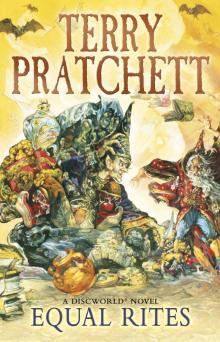 Equal Rites
Equal Rites A Hat Full of Sky
A Hat Full of Sky The Light Fantastic
The Light Fantastic Mrs Bradshaw's Handbook
Mrs Bradshaw's Handbook Wyrd Sisters
Wyrd Sisters Soul Music
Soul Music Small Gods
Small Gods Sourcery
Sourcery Reaper Man
Reaper Man Night Watch
Night Watch Lords and Ladies
Lords and Ladies The Fifth Elephant
The Fifth Elephant Monstrous Regiment
Monstrous Regiment The Truth
The Truth Witches Abroad
Witches Abroad Eric
Eric Going Postal
Going Postal Men at Arms
Men at Arms Jingo
Jingo The Amazing Maurice and His Educated Rodents
The Amazing Maurice and His Educated Rodents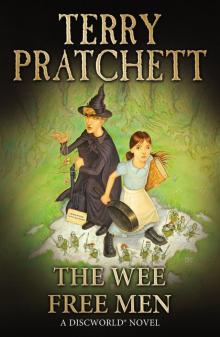 The Wee Free Men
The Wee Free Men Pyramids
Pyramids Wintersmith
Wintersmith Moving Pictures
Moving Pictures Carpe Jugulum
Carpe Jugulum Interesting Times
Interesting Times Maskerade
Maskerade Making Money
Making Money The Shepherd's Crown
The Shepherd's Crown Hogfather
Hogfather Troll Bridge
Troll Bridge The Last Continent
The Last Continent The Sea and Little Fishes
The Sea and Little Fishes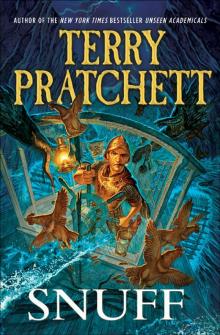 Snuff
Snuff Unseen Academicals
Unseen Academicals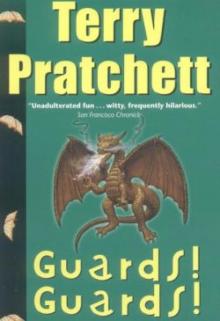 Guards! Guards! tds-8
Guards! Guards! tds-8 Jingo d-21
Jingo d-21 Turtle Recall: The Discworld Companion ... So Far
Turtle Recall: The Discworld Companion ... So Far The Fifth Elephant d-24
The Fifth Elephant d-24 Discworld 39 - Snuff
Discworld 39 - Snuff The Long War
The Long War Only You Can Save Mankind
Only You Can Save Mankind The Science of Discworld III - Darwin's Watch tsod-3
The Science of Discworld III - Darwin's Watch tsod-3 A Blink of the Screen: Collected Short Fiction
A Blink of the Screen: Collected Short Fiction Unseen Academicals d-37
Unseen Academicals d-37 Wings
Wings Making Money d-36
Making Money d-36 A Blink of the Screen
A Blink of the Screen Johnny and the Bomb
Johnny and the Bomb Dodger
Dodger Strata
Strata Discworld 02 - The Light Fantastic
Discworld 02 - The Light Fantastic The Folklore of Discworld
The Folklore of Discworld The Science of Discworld
The Science of Discworld The Unadulterated Cat
The Unadulterated Cat Raising Steam: (Discworld novel 40) (Discworld Novels)
Raising Steam: (Discworld novel 40) (Discworld Novels) The World of Poo
The World of Poo Discworld 05 - Sourcery
Discworld 05 - Sourcery The Witch's Vacuum Cleaner: And Other Stories
The Witch's Vacuum Cleaner: And Other Stories The Science of Discworld II - The Globe tsod-2
The Science of Discworld II - The Globe tsod-2 Small Gods: Discworld Novel, A
Small Gods: Discworld Novel, A Men at Arms tds-15
Men at Arms tds-15 Tama Princes of Mercury
Tama Princes of Mercury The Last Hero (the discworld series)
The Last Hero (the discworld series) The Long Utopia
The Long Utopia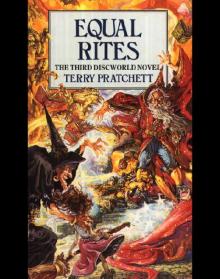 Discworld 03 - Equal Rites
Discworld 03 - Equal Rites Terry Pratchett - The Science of Discworld
Terry Pratchett - The Science of Discworld The Long Earth
The Long Earth The Carpet People
The Carpet People The Sea and Little Fishes (discworld)
The Sea and Little Fishes (discworld)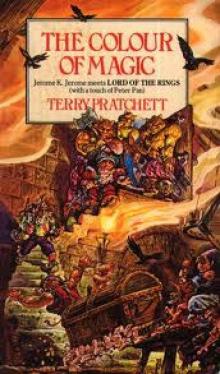 The Colour of Magic
The Colour of Magic Discworld 16 - Soul Music
Discworld 16 - Soul Music The Long Cosmos
The Long Cosmos The Dark Side of the Sun
The Dark Side of the Sun Monstrous Regiment tds-28
Monstrous Regiment tds-28 The Bromeliad 3 - Wings
The Bromeliad 3 - Wings Dragons at Crumbling Castle: And Other Stories
Dragons at Crumbling Castle: And Other Stories Night Watch tds-27
Night Watch tds-27 The Science of Discworld I tsod-1
The Science of Discworld I tsod-1 The Bromeliad 1 - Truckers
The Bromeliad 1 - Truckers The Science of Discworld Revised Edition
The Science of Discworld Revised Edition The Abominable Snowman
The Abominable Snowman Father Christmas’s Fake Beard
Father Christmas’s Fake Beard The Bromeliad Trilogy
The Bromeliad Trilogy A Slip of the Keyboard
A Slip of the Keyboard The Wee Free Men d(-2
The Wee Free Men d(-2 Johnny and the Dead
Johnny and the Dead Mrs Bradshaw's Handbook (Discworld Novels)
Mrs Bradshaw's Handbook (Discworld Novels) Truckers
Truckers The Amazing Maurice and His Educated Rodents d(-1
The Amazing Maurice and His Educated Rodents d(-1 Diggers
Diggers Thief of Time tds-26
Thief of Time tds-26 Science of Discworld III
Science of Discworld III Dragons at Crumbling Castle
Dragons at Crumbling Castle Nation
Nation Darwin's Watch
Darwin's Watch Interesting Times d-17
Interesting Times d-17 The Bromeliad 2 - Diggers
The Bromeliad 2 - Diggers The Science of Discworld II
The Science of Discworld II